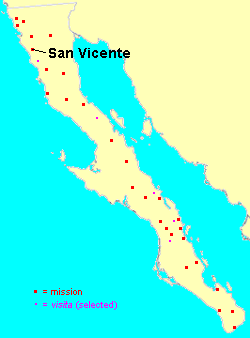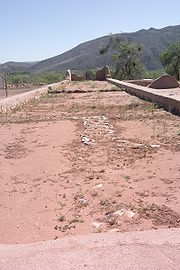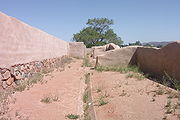
Misión San Vicente Ferrer
Encyclopedia

Mission San Vicente was founded in August 1780 by the Dominican
Dominican Order
The Order of Preachers , after the 15th century more commonly known as the Dominican Order or Dominicans, is a Catholic religious order founded by Saint Dominic and approved by Pope Honorius III on 22 December 1216 in France...
missionaries Miguel Hidalgo and Joaquin Valero among the Paipai
Paipai
The Paipai are an aboriginal people of northern Baja California, Mexico. They occupied a territory lying between the Kiliwa on the south and the Kumeyaay and Cocopa on the north, and extending from San Vicente near the Pacific coast nearly to the Colorado River's delta in the east...
Indians of northwestern Baja California
Baja California
Baja California officially Estado Libre y Soberano de Baja California is one of the 31 states which, with the Federal District, comprise the 32 Federal Entities of Mexico. It is both the northernmost and westernmost state of Mexico. Before becoming a state in 1953, the area was known as the North...
, Mexico.
San Vicente was one of the largest and most important of the Dominican missions, because of its fertile land, abundant water, and important location on the missions' Camino Real. It may have been even more important as an early military headquarters, charged with subduing the local groups and repelling assaults from the more warlike nations on the lower Colorado River
Colorado River
The Colorado River , is a river in the Southwestern United States and northwestern Mexico, approximately long, draining a part of the arid regions on the western slope of the Rocky Mountains. The watershed of the Colorado River covers in parts of seven U.S. states and two Mexican states...
.
As at other Baja California missions, the native population diminished under the impact of Old World diseases, the political climate became less favorable to the missions under an independent Mexico after 1821, and by 1833 the mission was abandoned.
Location and natural habitat
The mission was built in a place that is now called "LLano Colorado" or "Red Plain" because of the color of the volcanic rocks there. Today this land is cultivated during certain seasons and grows wheat and barley.Among the flora the missionaries found near the site would have been chamomile
Chamomile
Chamomile or camomile is a common name for several daisy-like plants of the family Asteraceae. These plants are best known for their ability to be made into an infusion which is commonly used to help with sleep and is often served with either honey or lemon. Because chamomile can cause uterine...
, ceanothus
Ceanothus
Ceanothus L. is a genus of about 50–60 species of shrubs or small trees in the buckthorn family Rhamnaceae. The genus is confined to North America, the center of its distribution in California, with some species in the eastern United States and southeast Canada, and others extending as far south...
, yucca
Yucca
Yucca is a genus of perennial shrubs and trees in the family Asparagaceae, subfamily Agavoideae. Its 40-50 species are notable for their rosettes of evergreen, tough, sword-shaped leaves and large terminal panicles of white or whitish flowers. They are native to the hot and dry parts of North...
, mesquite
Mesquite
Mesquite is a leguminous plant of the Prosopis genus found in northern Mexico through the Sonoran Desert and Chihuahuan Deserts, and up into the Southwestern United States as far north as southern Kansas, west to the Colorado Desert in California,and east to the eastern fifth of Texas, where...
, brushwood, oak
Oak
An oak is a tree or shrub in the genus Quercus , of which about 600 species exist. "Oak" may also appear in the names of species in related genera, notably Lithocarpus...
, and juniper
Juniper
Junipers are coniferous plants in the genus Juniperus of the cypress family Cupressaceae. Depending on taxonomic viewpoint, there are between 50-67 species of juniper, widely distributed throughout the northern hemisphere, from the Arctic, south to tropical Africa in the Old World, and to the...
. The animals and birds that lived in the region were squirrel
Squirrel
Squirrels belong to a large family of small or medium-sized rodents called the Sciuridae. The family includes tree squirrels, ground squirrels, chipmunks, marmots , flying squirrels, and prairie dogs. Squirrels are indigenous to the Americas, Eurasia, and Africa and have been introduced to Australia...
, mole
Mole (animal)
Moles are small cylindrical mammals adapted to a subterranean lifestyle. They have velvety fur; tiny or invisible ears and eyes; and short, powerful limbs with large paws oriented for digging. The term is especially and most properly used for the true moles, those of the Talpidae family in the...
, beaver
Beaver
The beaver is a primarily nocturnal, large, semi-aquatic rodent. Castor includes two extant species, North American Beaver and Eurasian Beaver . Beavers are known for building dams, canals, and lodges . They are the second-largest rodent in the world...
, shrew-mouse
Mouse
A mouse is a small mammal belonging to the order of rodents. The best known mouse species is the common house mouse . It is also a popular pet. In some places, certain kinds of field mice are also common. This rodent is eaten by large birds such as hawks and eagles...
, coyote
Coyote
The coyote , also known as the American jackal or the prairie wolf, is a species of canine found throughout North and Central America, ranging from Panama in the south, north through Mexico, the United States and Canada...
, puma, deer
Deer
Deer are the ruminant mammals forming the family Cervidae. Species in the Cervidae family include white-tailed deer, elk, moose, red deer, reindeer, fallow deer, roe deer and chital. Male deer of all species and female reindeer grow and shed new antlers each year...
, woodpecker
Woodpecker
Woodpeckers are near passerine birds of the order Piciformes. They are one subfamily in the family Picidae, which also includes the piculets and wrynecks. They are found worldwide and include about 180 species....
s, white-winged dove
White-winged Dove
The White-winged Dove is a dove whose native range extends from the south-western USA through Mexico, Central America, and the Caribbean. In recent years with increasing urbanization and backyard feeding, it has expanded throughout Texas and into Louisiana...
s, owl
Owl
Owls are a group of birds that belong to the order Strigiformes, constituting 200 bird of prey species. Most are solitary and nocturnal, with some exceptions . Owls hunt mostly small mammals, insects, and other birds, although a few species specialize in hunting fish...
, and wild duck
Duck
Duck is the common name for a large number of species in the Anatidae family of birds, which also includes swans and geese. The ducks are divided among several subfamilies in the Anatidae family; they do not represent a monophyletic group but a form taxon, since swans and geese are not considered...
s, among others.
The agricultural production consisted of corn
Maize
Maize known in many English-speaking countries as corn or mielie/mealie, is a grain domesticated by indigenous peoples in Mesoamerica in prehistoric times. The leafy stalk produces ears which contain seeds called kernels. Though technically a grain, maize kernels are used in cooking as a vegetable...
, bean
Bean
Bean is a common name for large plant seeds of several genera of the family Fabaceae used for human food or animal feed....
, wheat
Wheat
Wheat is a cereal grain, originally from the Levant region of the Near East, but now cultivated worldwide. In 2007 world production of wheat was 607 million tons, making it the third most-produced cereal after maize and rice...
, and barley
Barley
Barley is a major cereal grain, a member of the grass family. It serves as a major animal fodder, as a base malt for beer and certain distilled beverages, and as a component of various health foods...
crops, as well as different fruits and vegetables. The mission also had flocks of sheep and goat
Goat
The domestic goat is a subspecies of goat domesticated from the wild goat of southwest Asia and Eastern Europe. The goat is a member of the Bovidae family and is closely related to the sheep as both are in the goat-antelope subfamily Caprinae. There are over three hundred distinct breeds of...
s, herds of cattle
Cattle
Cattle are the most common type of large domesticated ungulates. They are a prominent modern member of the subfamily Bovinae, are the most widespread species of the genus Bos, and are most commonly classified collectively as Bos primigenius...
, horse
Horse
The horse is one of two extant subspecies of Equus ferus, or the wild horse. It is a single-hooved mammal belonging to the taxonomic family Equidae. The horse has evolved over the past 45 to 55 million years from a small multi-toed creature into the large, single-toed animal of today...
s and mule
Mule
A mule is the offspring of a male donkey and a female horse. Horses and donkeys are different species, with different numbers of chromosomes. Of the two F1 hybrids between these two species, a mule is easier to obtain than a hinny...
s.
Missionary compound

The buildings were surrounded by a wall with surveillance towers. There was also an irrigation system consisting of a dam and stone-lined ditches for watering the fields.
Methods of construction
The buildings of the complex were made of adobeAdobe
Adobe is a natural building material made from sand, clay, water, and some kind of fibrous or organic material , which the builders shape into bricks using frames and dry in the sun. Adobe buildings are similar to cob and mudbrick buildings. Adobe structures are extremely durable, and account for...
, with round stone foundations that were set 90 centimeters deep and cemented with a mortar of clay, sand and lime. The adobe bricks were positioned on the foundation using an alternating technique to give them strength and stability. They were bonded with the same mortar, forming walls from 0.9 to 1.1 meters thick. The adobe was made with local soil, water, clay, sand, and straw to make it more resistant. The walls probably reached a height of 4.5 meters, and the roofs were interlaced with reeds over oak beams.
Military installation

Loreto, Baja California Sur
Loreto was the first Spanish settlement on the Baja California Peninsula. It served as the capital of Las Californias from 1697 to 1777, and is the current seat of the municipality of Loreto in the Mexican state of Baja California Sur...
presidio in what is now Baja California Sur
Baja California Sur
Baja California Sur , is one of the 31 states which, with the Federal District, comprise the 32 Federal Entities of Mexico. Before becoming a state on October 8, 1974, the area was known as the South Territory of Baja California. It has an area of , or 3.57% of the land mass of Mexico and comprises...
who lived in a walled compound. The military installation was also to protect the territory between the missions of San Fernando de Velicatá
Misión San Fernando Rey de España de Velicatá
Located in Baja California, Mexico about 200 miles south of Ensenada, Misión San Fernando Rey de España de Velicatá was the only mission founded by Franciscans in Baja California....
and San Diego
Mission San Diego de Alcalá
Mission Basilica San Diego de Alcalá, in San Diego, California, was the first Franciscan mission in the Las Californias Province of the Viceroyalty of New Spain. It was founded in 1769 by Spanish friar Junípero Serra in an area long inhabited by the Kumeyaay Indians...
.
Native Americans of the region
The San Vicente Ferrer is located in PaipaiPaipai
The Paipai are an aboriginal people of northern Baja California, Mexico. They occupied a territory lying between the Kiliwa on the south and the Kumeyaay and Cocopa on the north, and extending from San Vicente near the Pacific coast nearly to the Colorado River's delta in the east...
territory. This Native American group belongs to the Yuman language family, and their territory extends from the Pacific coast over mountains and deserts to the Gulf of California
Gulf of California
The Gulf of California is a body of water that separates the Baja California Peninsula from the Mexican mainland...
. Today there are 300 Paipai (or Jaspuy Paium as they call themselves) living in two communities: Santa Catarina
Misión Santa Catarina Virgen y Mártir
Mission Santa Catarina was founded on November 12, 1797 in the present-day Valle of El Álamo in the municipio of Ensenada, Baja California, México, by the Dominican missionary José Loriente....
in the Sierra Juárez
Sierra Juárez
Sierra de Juárez is a mountain range on the Baja California Peninsula, of Baja California, Mexico. It is part of the Peninsular Ranges. The Laguna Mountains of California lie to the north and the Sierra San Pedro Mártir lies to the south....
and San Isidoro to the south near Trinidad Valley.
In 1782 the native population at San Vicente was estimated to be 83 converts, rising to 317 in 1787 and dropping to 246 in 1800.
Conservation

National Institute of Anthropology and History
The Instituto Nacional de Antropología e Historia is a Mexican federal government bureau established in 1939 to guarantee the research, preservation, protection, and promotion of the prehistoric, archaeological, anthropological, historical, and paleontological heritage of Mexico...
. The collapsed roofs that a group called "Pro-Rescate de los Sitios Misionales de Baja California" had placed in 1979 have been removed. The remains of the walls are covered by a sacrificial layer made of clay, sand, water, slices of nopal
Nopal
Nopales are a vegetable made from the young cladode segments of prickly pear, carefully peeled to remove the spines. These fleshy pads are flat and about hand-sized. They can be purple or green...
cactus, and manure to protect them from the wind, sunlight, and rain. Archaeological excavations were begun at the site in 1997.
See also
- Spanish missions in Baja CaliforniaSpanish missions in Baja CaliforniaThe Spanish Missions in Baja California comprise a series of religious outposts established by Spanish Catholic religious orders, the Jesuits, the Franciscans and the Dominicans, between 1683 and 1834 to spread the Christian doctrine among the local natives...
- Spanish missions in CaliforniaSpanish missions in CaliforniaThe Spanish missions in California comprise a series of religious and military outposts established by Spanish Catholics of the Franciscan Order between 1769 and 1823 to spread the Christian faith among the local Native Americans. The missions represented the first major effort by Europeans to...

